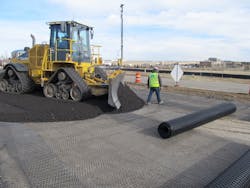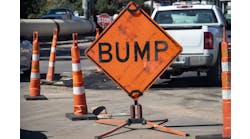By: Paul Schmitz, Tensar International Corporation
Now that the $2 trillion Phase 3 portion of the Coronavirus Aid, Relief and Economic Security (CARES) Act has been officially signed into law and implemented, attention is turning towards a potential Phase 4. The goal of Phase 4 would be to provide additional funding to address the ongoing economic challenges of the pandemic. President Trump has expressed his desire for this to include large investments in infrastructure, tweeting last month, “It should be VERY BIG & BOLD, Two Trillion Dollars, and be focused solely on jobs and rebuilding the once great infrastructure of our Country!”
Before we can address a massive infrastructure spending bill, states need immediate federal assistance to keep their crucial programs going. Susan Howard, Program Director for Transportation Finance at AASHTO, remarked that, “Most states have seen a 30-50% drop in revenue due to stay home orders.” With fewer people driving, reducing revenues collected from gas taxes and other means, an estimated $50 billion will be needed to make up for this shortfall over the next 18 months. Some states are already suspending new construction, while others are only moving forward on a few key projects. Howard concludes, “Funding for state DOTs lifts all boats.” The general consensus seems to be this important stop-gap investment for DOTs will happen much sooner than a larger, long-term infrastructure plan.
Once this immediate need is met, a more extensive infrastructure bill will be key to not only stimulating our economy, but also delivering the critical improvements that are long overdue. As Ms. Howard mentioned, “the FAST Act is expiring in September of this year, and it is critical for our government to have something in place to address the massive infrastructure gap.” Treasury Secretary Steve Mnuchin has held discussions with both Republican and Democratic members of congress regarding this package, resulting in large differences in the overall proposed amount of financial relief. President Trump would like to see $2 trillion over 10 years, while the Democrats are leaning towards $760 billion over five years. Interest in infrastructure spending is not just limited to the political circles in Washington. Many industry associations such as the American Road & Transportation Builders Association (ARTBA) and the America Highway Users Alliance (AHUA) have written letters to members of Congress pushing for this bill. Even prominent non-politician, non-industry figures such as Mark Cuban have recognized the importance of infrastructure investment, especially in next-generation technology. With this impending legislation, the million-dollar—or rather trillion-dollar—question becomes: What can state DOT and local public works agencies do now to prepare for a massive infrastructure stimulus package? And once the funds are received, how do you get the maximum value?
As we recall from the American Recovery and Reinvestment Act (ARRA) of 2009, projects that were considered “shovel-ready” received priority for funding instead of rewarding funds on a first come, first served basis. The first task at hand should be deciding which projects to expedite to shovel-ready status. Local transportation agencies should employ a coordinated, data-driven approach to identify the most needed projects.
Pavement Condition Reports and Benefit-Cost Ratio Analysis (BCA) are just two of the tools agencies use to prioritize road and highway repair needs. For example, the Oregon DOT performs a biennial pavement report on its high traffic roads using a Pavement Data Collection Vehicle. This detailed analysis accurately gathers data and then assigns a score from 0-100, with the Fair-Better Line at 46. The agency recognizes that, “Timely maintenance and preservation by performing the right treatment to the right road at the right time is by far the most efficient way to preserve the public’s investment.”
Local agencies such as McLean County in Illinois use BCA to determine the ranking of roads for repair and replacement. This kind of analysis not only uses the initial capital costs, but also factors in other variables such as improvements in public safety, limiting adverse effects on travel, and life-cycle costs. Applied correctly, BCA can support the selection and prioritization of projects that have the best potential to achieve long-term performance objectives of transportation investments. In a recent analysis, the county looked at 20 potential projects and ranked them according to their benefit-cost ratio number. The projects with the greater B-C ratios would most likely get priority over projects ranked lower.
Another example of an agency using real-world data to not only prioritize projects but also stretch its roadway budget further comes from a historic town just outside of Boston, Massachusetts. The town of Lexington, well known in American Revolutionary history as the location of “the shot heard round the world,” is leading the way in effective planning for its town-maintained roadway system. Since 2010, the town has implemented a comprehensive engineering study to help categorize pavement conditions for its more than 130 miles of roadways. Most recently, BETA Group Inc. was hired by the town and began a three-phase field inspection process in 2017, with the final phase completed in 2019. Town Engineer John Livsey states “We update the report each year with the work that is performed as well as a resurvey of a third of our roads. This keeps our data up to date with a very limited outlay of funding.” By predicting the deterioration of roadways over time, the town of Lexington has built an effective pavement management system to cost-effectively maintain and repair roads versus performing complete replacements after failure. Their Pavement Management Plan (PMP) for FY2020 summarized its purpose and methodology by stating: “The PMP is a planning tool intended to provide the foundation to manage the town’s roadway resources by combining professional engineering metrics with local institutional knowledge.”
The PMP showed Lexington to have an overall RSR of 84.93 across its entire network of roadways. The town has set up five repair strategies from Defer Maintenance to Major Rehabilitation along with a corresponding cost per square yard, based on the RSR value of each specific road segment. Using this real-world data, the town created a strategic plan for prioritizing road projects based on overall budget available. Livsey said, “The key is to follow a ‘best-first’ approach and stick to it. You need to maintain the roadways that are in good condition. Find the roads that are in pavement preservation mode and be sure to focus on them and not let them fail.” Using this data, the town created a Backlog Summary to monitor the progress of the program and to ensure the backlog continues in a decreasing trend.
As part of a summary of the town’s PMP, they established a set of best practices to help manage this process. One practice would be to continuously update the unit costs for each of their repair methods. Material and labor costs, as well as the paving and rehab costs, vary year to year. The conclusion of the town’s report notes, “The Pavement Management Program will serve as a valuable instrument ... and facilitate a progressive approach to managing roadway infrastructure.” The Beta Group’s report analyzed 131.56 miles of roadways in Lexington and applied a Road Surface Rating (RSR) for all their road segments. The chart below shows the relationship between pavement condition (RSR) and its deterioration over time.
Using identification systems like these should be only part of the overall infrastructure planning process. Once a project is identified, the next step is to evaluate design solutions that stretch investment dollars further while reducing the impacts on the local infrastructure. Some examples would include improving resiliency of roadways, reducing construction costs and time, and increasing safety of construction.
Making these types of evaluations may be standard procedure for state DOTs or other large design groups, but for local municipalities, calculating and comparing this data can be very time consuming and costly. However, local agencies and designers can benefit greatly by relying on technology and design methods already developed by companies focused on the needs of public works departments. For example, geogrid, a type of geosynthetic made especially for trafficked surfaces, can be incorporated into enhanced pavement designs to improve the structural capacity and durability of roads. Pavement designs incorporating geogrid can increase the life of the roadway with less aggregate or thinner pavement layers, resulting in a more cost-effective solution versus other methods. Local agencies and designers will especially appreciate its third-party validated pavement design software that compares scenarios for various types of cost savings and life-cycle benefits.
A Phase 4 stimulus package would provide funding for much needed projects at the local level. Municipalities that gather data, prioritize projects based on findings and long-term performance, perform economic impact assessments, and design ahead of time will be the ones that reap the greatest benefit. Researching new technologies and using proven resources already developed will help municipalities accomplish design work faster, while stretching stimulus dollars further.
About The Author: Schmitz is Market Manager for Public Roads, Tensar International Corporation.






